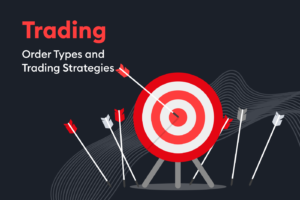
Have you ever wondered how online share trading platforms handle your orders? These platforms provide different order options to match various trading styles and goals. Market orders make sure that fast trades at the current market price, while limit orders allow you to specify the price at which you want to buy or sell. Stop orders automatically trigger trades at specific prices to protect against potential losses. Understanding these order types helps you navigate online trading confidently, make informed decisions, and seize opportunities quickly. Mastering these tools empowers you to optimize your trading strategy and navigate the complexities of online trading effectively. Let’s dive into a variety of order types they offer to enhance your trading strategy:
- Market Orders– Perhaps the simplest of the common trading orders is the market order, a form of instruction involving the immediate buying or selling of any security on the platform at the best possible price. This would be more appropriate for traders who would want quick execution and be willing to accept whatever price exists in the market at that time. The advantages of a market order primarily include immediacy, which ensures that the transaction will be executed as quickly as possible. One downside is that the final executed price may differ slightly from the price seen at order placement. This can be particularly true in volatile markets where prices change quickly. Market orders are indicated when prompt execution is more important than precise pricing.
- Limit Orders– The limit orders allow a trader to indicate the quantity of what one is willing to pay for any security or inversely at which price the security will be sold. A buy limit order is executed when the security price reaches or falls below one’s limit price, whereas on the other hand, a sell limit order will be executed when the price of a security rises to or goes above one’s limit price. Such orders are beneficial for traders looking to fill positions or exit them at some predetermined price, more so in less liquid markets where prices change widely. The main limitation is that a limit order may not be executed if the market price does not hit the set limit, thus missing the trade.
- Stop orders– Stop orders are like a safety switch in trading that automatically starts trades when prices hit a certain point. They’re designed to be safe against losses by selling assets at specific prices. For example, imagine you own the stock that’s currently priced at $50. You’re concerned it might drop significantly if it falls below $45. To protect your investment, you can set the stop order at $45. If the stock price drops to $45 or below, a stop order triggers the sale to avoid further losses. This proactive method helps traders lower risks and save their investments based on predefined price levels.
- Stop-limit orders– Stop-limit orders combine the aspects of stop or limit orders to help you manage your trading risks. Here’s how they function: Imagine you want to buy or sell stock at a particular price, but you also want to set a price level that irritates the trade. For instance, if a stock is trading at $50 and you think it will go up but you only want to buy if it stays below $55, you can set a stop-limit order with a stop price of $52. If the stock reaches $52, the order kicks in and tries to buy at or below $55 to get the best possible price.
- Fill-or-kill order– Fill-or-kill orders make sure that large trades are either fully executed immediately or canceled altogether. This type of order is useful for traders who want to complete long transactions quickly without any partial fills. As an illustration, if you set the fill-or-kill order to buy 1,000 shares of the stock at $50 each, the order will only completed if you can buy all 1,000 shares immediately at that price. If not, an order is canceled to avoid incomplete transactions. This method makes sure trades are managed effectively, lowering the risks of incomplete executions causing problems.
- Immediate-or-cancel orders– Immediate-or-cancel orders aim for instant execution and will take some of your order if it can’t be completed all at once. It can be used by traders for quick orders, but these traders would be satisfied only with the partial order. For instance if one has placed an immediate-or-cancel order to buy one thousand of stock and only eight hundred of them are available at the required price, then the order buys eight hundred of the shares immediately while the rest of the order is canceled. It allows us to make quick decisions when the entire order cannot be filled immediately.
- Good ‘Til Canceled Orders– Good ’til canceled orders stay active until you choose to cancel them, giving you freedom in handling your trades. This kind of order is favorable for investors who wish to open trades that may take more than a single day. For example, if you set a good ’til canceled order to buy the stock at a certain price, the order stays active until you either buy the stock at that price or cancel the order yourself. It allows you to make trading decisions without having to set new orders every day.
In conclusion, understanding and using various types of orders available on investment platforms can significantly improve how you trade. Whether you have quick trades with market orders, setting specific prices with limit orders, and managing risk with stop or stop-limit orders, each choice helps you shape your trading strategy. For larger trades, fill-or-kill and all-or-none orders ensure trades happen as you want. Immediate-or-cancel orders allow you to take only part of an order if needed. Good ’til canceled orders stay active until you decide to cancel them. More complex order types like one cancels the other or one triggers the other also help to make trading easier. By using these tools on platforms for investing, you can make smarter investment decisions, manage risk better, and get better results with your trading.


